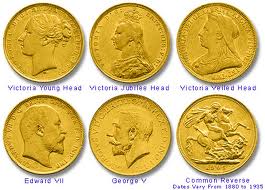Coin Grading Guide
There are two main coin grading systems in use: the UK grading scale and the US grading scale. While it’s possible to grade coins yourself, doing so correctly takes years of experience. Though there is a scientific basis for grading, it really is more of an art that takes a keen eye and a high level of attention to detail. The grading of a coin is the basis of its valuation, so it’s important to understand the grading scale before any attempt at valuation is made.
The UK Grading Scale
 As in the US scale, different grades are given different symbols. There are four main grades:
As in the US scale, different grades are given different symbols. There are four main grades:
Fine (F): the coin is worn over the whole area, but only the highest spots are worn completely.
Very Fine (VF): the detail is clear, but wear and tear makes it obvious that the coin has been in circulation. Though the high spots are worn, the detail is noticeable. There may be traces of lustre from the minting between the letters of the inscription.
Extremely Fine (EF): high spots have suffered only slight wear, and other detailing is sharp. Much of the coin still has its mint lustre.
Uncirculated (Unc): there is no wear, though there may be ‘bag abrasions’ present. Mint lustre is significant, though older coins may suffer from tarnishing or toning.
Below these four main grading tiers, you may hear the following descriptions:
Poor: inscriptions are worn, dates cannot be read, and only an outline of the design is visible. Such coins will have very little value.
Fair: though the date is visible, and the type recognisable, very little detail can be picked out.
Good (G): inscriptions are worn, but visible, as is the detail. Sometimes this is referred to as mediocre.
Very Good (VG): The coin has suffered considerable wear over the whole of its surface, and high spots are worn through. Such coins have real value only if extremely rare.
At the other end of the scale, there are further grades for coins considered to be in the best of condition:
Brilliant Uncirculated (BU): a coin with full mint lustre and no toning.
Fleur de Coin (FDC): a coin that is in perfect mint state with a full lustre, and absolutely no marks or abrasions, and no toning. Such coins are usually proof coins, and will not have been in contact with other coins during their lifetime.
Many coins fall between these grades, and so terms such as nearly EF, gem BU, AEF (almost EF), and EF+ (better than EF but not Unc).
The Coin Grading Service (CGS UK), now closed, was a UK company established in 2006 that specialises in grading services for the collector. Its grading system uses the system above, but then assigns a coin a numerical value between 1 and 100 to further establish condition. This grading system brings it closer to the US system.
Trade Gold Prices At The Leading Brokers
-
Pocket Option offers ultra-short-term binaries from 5 seconds on one of the simplest web platforms for beginners. Payouts rival alternatives at 90%+ while the ‘Double Up’ and ‘Rollover’ features provide further opportunities to profit. Considering the negatives, the suite of 130+ assets trails binary brokers like Quotex, which offer 400+.
-
IQCent offers binary options with above-average payouts up to 98%. The broker supports an online platform with basic analysis tools but a wide range of timeframes, from 1 minute to 1 month, catering to short and long term trading strategies. Considering the negatives, there are no binaries on stocks.
-
CloseOption offers binary options trading on 30+ fiat and digital currencies through an easy-to-use web-based platform. 15 contract timeframes are available from 30 seconds to 1 month, suiting both short-term and long-term traders. New users also get a joining gift.
The US Grading Scale
The US grading scale is more dependent on a numbering system than letters, and the leading US coin graders, such as the Professional Coin Grading Service (PCGS) rigidly apply the 70 point scale.
From the lowest grade of Poor 1 (PO1) that is the equivalent of the UK Poor, the scale moves as follows (though there are grades between the following):
F2: equivalent to the UK’s Fair (F)
G4 to G7: equivalent to the UK’s Good (G)
VG8 to VG11: equivalent to the UK’s Very Good (VG)
F12 to F14: equivalent to the UK’s Fine (F)
VF25 to VF30: equivalent to the UK’s Very Fine (VF)
EF40 to EF44: equivalent to the UK’s Extremely Fine (EF)
MS67 to MS69: equivalent to the UK’s Brilliant Uncirculated (BU)
MS70; equivalent to the UK’s Fleur de Coin (FDC)
Beware
A word of warning when either grading coins yourself or reading grades: it is natural for a collector to believe that his coin is in better condition than it actually is. As the grade affects the value, it is always worth seeking professional and independent grading advice before buying a coin with a high valuation.
Also be aware that the obverse (the side with the head) and reverse of a coin can be worn at different rates, and so it is not unusual to see a coin graded differently for each of its sides.

